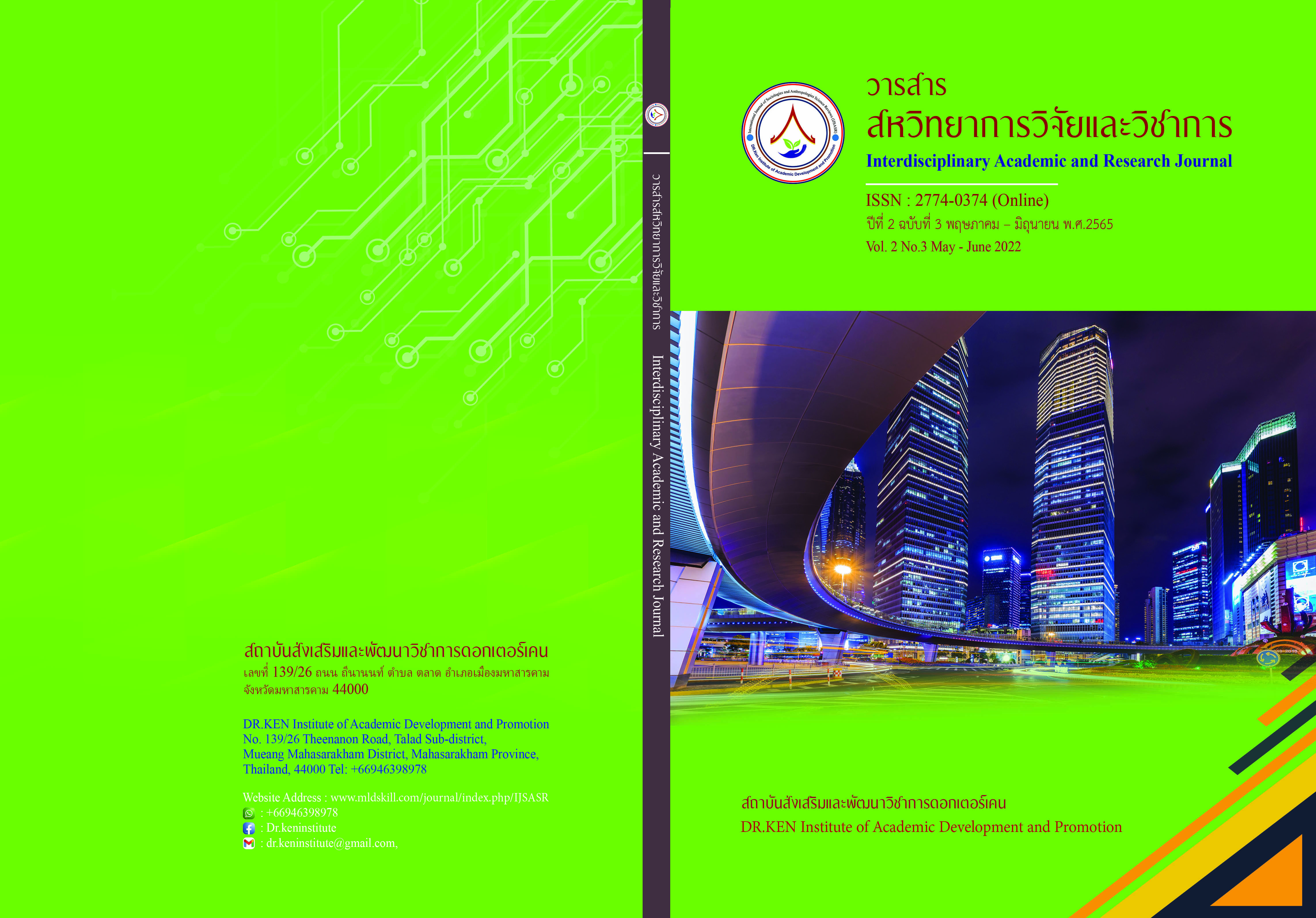Civara: The Politics of Dhammayuttika Nikaya Buddhism Robe Usage in Thailand
DOI:
https://doi.org/10.14456/iarj.2022.35Keywords:
Funeral Robe; , Theravada Buddhism; , Thammayuth Sect.Abstract
The robe is derived from the word requiem robe. In the early age of the Lord Buddha, he only allowed his disciples to use the word requiem robe. it was later obtained from the villagers, but the robe pattern and robes remained unknown. On one occasion, the Buddha was walking through the Thaksina Khiri countryside when he came across a Bihar. As a result, Phra Anon was assigned to sew a robe in the Khanna style until it became an art form of clothing for Buddhist monks particularly those of the Theravada in Thailand. Vajirayan Bhikkhu (King Rama IV during his matriculation) founded the Dhammayuttika Nikaya in 1936, and he instituted customs and practices that differed from the original sect, such as the color of robes, patterns and methods of robe-covering, and so on. The Raman robe is worn by the Dhammayut sects as a symbol of pragmatism and political acceptance. Furthermore, the 2014 announcement regarding the use of robe colors requiring Phra Dhammayut sects throughout the diocese to wear royal-colored robes created a ripple effect and brought a concrete approach to the area of power.
References
กรรมการบริหารคณะธรรมยุต. (2547). ประวัติคณะธรรมยุต. กรุงเทพฯ : มหามกุฏราชวิทยาลัย.
ณัฐ จันทร์หนูหงส์และมนตรี สิระโรจนานันท์. (2560). รูปแบบการถวายผ้าบังสุกุลจากสมัยพุทธกาลสู่ยุคปัจจุบัน. วารสารพุทธปัญญาปริทรรศน์ มจร, 2 (3), 76-88.
ทรงวิทย์ แก้วศรีและคณะ. (2563). การศึกษาบทบาทของพระพุทธเจ้าในฐานะทรงเป็นต้นแบบนวัตกรรมเครื่องนุ่งห่ม ที่เป็นมิตรกับธรรมชาติและสิ่งแวดล้อม: กรณีศึกษาเฉพาะผลิตภัณฑ์จีวร. วารสารบาฬีศึกษาพุทธโฆสปริทรรศน์ มจร, 6 (2), 15-26.
ปฐม นิคมานนท์. (2546). พระครูวิเวกพุทธกิจ (หลวงปู่เสาร์ กันตสีโล) พระปฐมอาจารย์ใหญ่ฝ่ายพระกรรมฐาน โครงการหนังสือบูรพาจารย์เล่ม 5. กรุงเทพฯ : พี.เอ.ลิฟวิ่ง.
พระกฤษฎิ์ณวัช ปภากโร (เกษกิจ) และศุลีพร เศวตพงษ์. (2557). การพิจารณาจีวรในพระพุทธศาสนาเถรวาท. วารสารครุศาสตร์ปริทรรศน์ฯ, 1 (1), 146-158.
พระครูปลัดสุวัฒนวชิรคุณ. (2564). ความแตกต่างของสีและการห่มจีวรของพระสงฆ์ในพุทธศาสนา. [Online] www.komchadluek.net [25 พฤษภาคม 2553]
พระพรหมคุณาภรณ์ (ป.อ. ปยุตฺโต). (2556). พจนานุกรมพุทธศาสน์ ฉบับประมวลศัพท์. พิมพ์ครั้งที่ 21, กรุงเทพฯ : ผลิธัมม์.
พระพุทธโฆษาจารย์. (2551). คัมภีร์วิสุทธิมรรค. พิมพ์ครั้งที่ 7, กรุงเทพฯ : ธนาเพรส.
พระมหาปุณณ์สมบัติ ปภากโร (บุญเรือง) และคณะ (2563). ธรรมยุติกนิกาย : จุดเชื่อมต่อ ลังกา รามัญ สยาม, วารสารปรัชญาและศาสนา มหาวิทยาลัยขอนแก่น, 5 (2), 119-139.
พระมหาวิรัตน์ อาจารสุโภและคณะ. (2562). การวิเคราะห์อริยวังสปฏิปทาในคัมภีร์พระพุทธศาสนา. วารสารสันติศึกษาปริทรรศน์ มจร., 7 (2), 435-446.
ภูวมินทร์ วาดเขียน. (2553). การสถาปนาธรรมยุตินิกายของวชิรญาณภิกขุ : ปัญหาเรื่องสังฆเภท. วิทยานิพนธ์ศิลปศาสตรมหาบัณฑิต (พุทธศาสตร์ศึกษา) : จุฬาลงกรณ์มหาวิทยาลัย
มหามกุฏราชวิทยาลัย. (2553). มหาสมณานุศาสน์. กรุงเทพฯ: มหามกุฏราชวิทยาลัย.
วันทนีย์ ส่งศิริ. (2525). การขึ้นครองราชย์ของพระบาทสมเด็จพระจอมเกล้าเจ้าอยู่หัว. ปริญญานิพนธ์ปริญญามหาบัณฑิต: มหาวิทยาลัยศิลปากร.
สมเด็จพระมหาสมณเจ้า กรมพระยาวชิรญาณวโรรส, (2543). วินัยมุข [เล่ม 2]. พิมพ์ครั้งที่ 31, กรุงเทพฯ: มหามกุฏราชวิทยาลัย,
สมเด็จพระมหาสมณเจ้า กรมพระยาวชิรญาณวโรรส. (2553). พระประวัติตรัสเล่า. กรุงเทพฯ : มหามกุฏราชวิทยาลัย,
สมเด็จพระมหาสมณเจ้า กรมพระยาวชิรญาณวโรรส. (2553). มหาสมณานุศาสน์. กรุงเทพฯ : สุรวัฒน์,
สุนทรี สุริยะรังษี. (2559. จีวร : การตัดเย็บจากอดีตถึงปัจจุบัน. วารสารครุศาสตร์ปริทรรศน์ฯ, 3 (2), 1-12.
สุชีพ ปุญญานุภาพ. (2560). พระไตรปิฎกฉบับประชาชน, ฉบับ 100 ปีชาตกาลสุชีพ ปุญญานุภาพ. กรุงเทพฯ : มูลนิธิพระไตรปิฎกเพื่อประชาชน.
J. L.Taylor. (1993). Forest Monks and the Nation-state. Singapore: Institute of Southeast Asian Studies.
Sãi Bản Mường. (2564). จีวรสีดั้งเดิมครั้งพุทธกาล. [Online] web.facebook.com/profile. 2564. [27 กันยายน 2564]
Downloads
Published
How to Cite
Issue
Section
License
Copyright (c) 2022 PhramahaPunsombat Pabhakaro, PhrabaidhikaChaatchawan Ariyametee, Prateep Peuchthonglanglang

This work is licensed under a Creative Commons Attribution-NonCommercial-NoDerivatives 4.0 International License.
Copyright on any article in the Interdisciplinary Academic and Research Journal is retained by the author(s) under the under the Creative Commons Attribution-NonCommercial-NoDerivatives 4.0 International License. Permission to use text, content, images, etc. of publication. Any user to read, download, copy, distribute, print, search, or link to the full texts of articles, crawl them for indexing, pass them as data to software, or use them for any other lawful purpose. But do not use it for commercial use or with the intent to benefit any business.
















.png)


